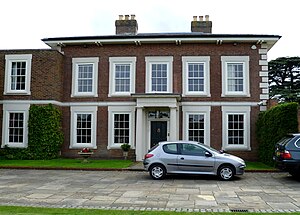Lemmons
| Lemmons | |
|---|---|

July 2015
|
|
| Alternative names | Gladsmuir, Gladsmuir House |
| General information | |
| Status | Grade II listed building |
| Type | Residential house |
| Architectural style | Georgian |
| Location | Hadley Common, Monken Hadley, London Borough of Barnet, EN5 |
| Country | England |
| Coordinates | 51°39′37″N 0°11′32″W / 51.6603°N 0.1922°W |
| Construction started | c. 1830 |
| Technical details | |
| Floor count | Two storeys |
| Grounds | Over eight acres |
| Other information | |
| Number of rooms | Over 20 |
| Parking | Gravel drive |
Lemmons, also known as Gladsmuir and Gladsmuir House, was the home of novelists Kingsley Amis (1922–1995) and Elizabeth Jane Howard (1923–2014) on the south side of Hadley Common, Barnet, on the border of north London and Hertfordshire.
The couple bought the Georgian five-bay villa (built around 1830) for £48,000 at auction in 1968, along with its eight acres of land, and lived there until 1976. The house had been registered as a Grade II listed building in 1949 under the name Gladsmuir, previously known as Gladsmuir House. Jane Howard restored an earlier name, Lemmons; the next owners changed it back to Gladsmuir.
Jane and Kingsley lived at Lemmons with Jane's mother and brother, two artist friends, and Kingsley's three children, including the novelist Martin Amis. Several of the family's novels were written at Lemmons: Kingsley's The Green Man (1969) and The Alteration (1976), Jane's Odd Girl Out (1972) and Mr. Wrong (1975), and Martin's The Rachel Papers (1973) and Dead Babies (1975).
The poet laureate Cecil Day-Lewis stayed at Lemmons in the spring of 1972, when he was dying of cancer, accompanied by his wife, Jill Balcon, and their children, Daniel Day-Lewis and Tamasin Day-Lewis. He wrote his last poem in the house, "At Lemmons", and died there shortly afterwards.Ian Sansom writes that, for the brief period that the Amises, Howards, Day-Lewises and others were in residence, Lemmons became "the most brilliantly creative household in Britain".
...
Wikipedia
